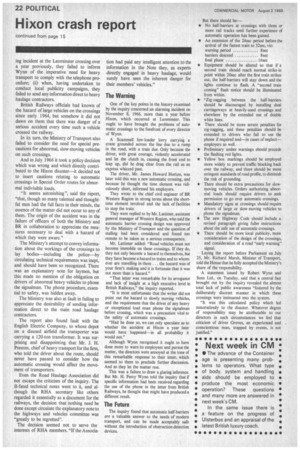Hixon crash report
Page 24

If you've noticed an error in this article please click here to report it so we can fix it.
continued from page 15 mg incident at the Leominster crossing over a year previously, they failed to inform Wynn of the imperative need for heavy transport to comply with the telephone procedure; (ii) when, having undertaken to conduct local publicity campaigns, they failed to send any information direct to heavy haulage contractors.
British Railways officials had known of the hazard of large vehicles on the crossings since early 1964, but somehow it did not dawn on them that there was danger of a serious accident every time such a vehicle crossed the railway.
In its turn, the Ministry of Transport also failed to consider the need for special precautions for abnormal, slow-moving vehicles on such crossings.
And in July 1966 it took a policy decision which was wrong and which directly contributed to the Hixon disaster—it decided not to insert cautions relating to automatic crossings in Special Order routes for abnormal indivisible loads.
"It seems astonishing", said the report, "that, though so many talented and thoughtful men had the full facts in their minds, the essence of the matter did not occur to any of them. The origin of the accident was in the failure of officers of both the Ministry and BR in collaboration to appreciate the measures necessary to deal with a hazard of which they were aware."
The Ministry's attempt to convey information about the workings of the crossings to lay bodies—including the police—by circulating technical requirements was inept, and should have been so recognized. There was an explanatory note for laymen, but this made no mention of the obligation on drivers of abnormal heavy vehicles to phone the signalman. The phone procedure, essential to safety, was hidden away.
The Ministry was also at fault in failing to appreciate the desirability of sending information direct to the main road haulage contractors.
The report also found fault with the English Electric Company, to whose depot on a disused airfield the transporter was carrying a 120-ton transformer. It was surprising and disappointing that Mr. J. H. Preston, chief of heavy transport for the firm, who told the driver about the route, should never have paused to consider how the automatic crossing would affect the movement of transporters.
Even the Road Haulage Association did not escape the criticism of the inquiry. The ill-fated technical notes went to it, and although the RHA secretary like others regarded it essentially as a document for the railways, the decision that nothing need be done except circulate the explanatory note to the highways and vehicles committee was "greatly to be regretted".
The decision seemed not to serve the interests of REA members. "If the Associa
tion had paid any intelligent attention to the information in the Note they, as experts directly engaged in heavy haulage, would surely have seen the inherent danger for their members' vehicles."
The Warning
One of the key points in the history examined by the inquiry concerned an alarming incident on November 8, 1966, more than a year before Hixon, which occurred at Leominster. This ought to have brought the problems of automatic crossings to the forefront of every director of Wynn.
A Scammell low-loader lorry carrying a crane grounded across the line due to a ramp in the road, with a train due. Only because the driver, with great courage, violently accelerated and let the clutch in, causing the front end to leap up, did he drag clear from the rail as an express whizzed past.
The driver, Mr. James Howard Horton, was later told this was a new automatic crossing, and because he thought the time element was ridiculously short, informed his employers.
They wrote to the chief civil engineer of BR Western Region in strong terms about the shorttime element involved and the lack of facilities to stop the train.
They were replied to by Mr. Lattimer, assistant general manager of Western Region, who said the automatic barrier crossing design was approved by the Ministry of Transport and the question of stalling had been considered and found too remote to be taken as a serious consequence.
Mr. Lattimer added: "Road vehicles must not become immobile on these crossings. If they do, they not only become a hazard to themselves, but they have become a hazard to trains and to whomever are travelling in them. .. the hazard was of your firm's making and it is fortunate that it was not more than a hazard."
"That letter was remarkable for its arrogance and lack of insight at a high executive level in British Railways," the inquiry reported.
"It is most unfortunate that the writer did not point out the hazard to slowly moving vehicles, and the requirement that the driver of any heavy or exceptional load must phone the signalman before crossing, which was a precaution vital to the safety of automatic crossings.
"Had he done so, we can only speculate as to whether the accident at Hixon a year later would have happened—in all probability it would not."
Although Wynn recognized it ought to have done more to warn its employees and pursue the matter, the directors were annoyed at the tone of this remarkable response to their letter, which seemed to them to preclude further discussion. And so they let the matter rest.
This was a failure to draw a glaring inference. But Mr. H. Percy Wynn told the inquiry that if specific information had been received regarding the use of the phone in the letter from British Railways, he thought that might have produced a different result.
The Future The inquiry found that automatic half-barriers are a valuable answer to the needs of modern transport, and can be made acceptably safe without the introduction of obstruction-detection devices.




































































































